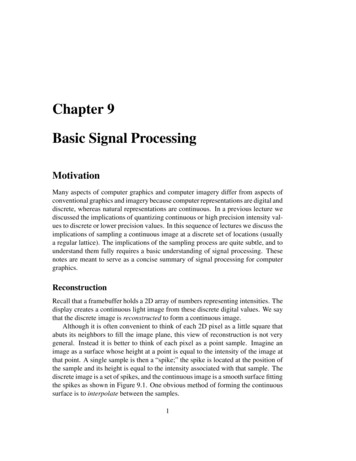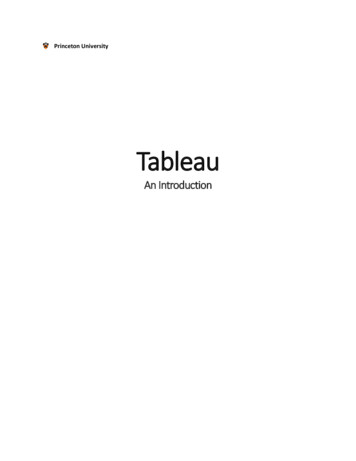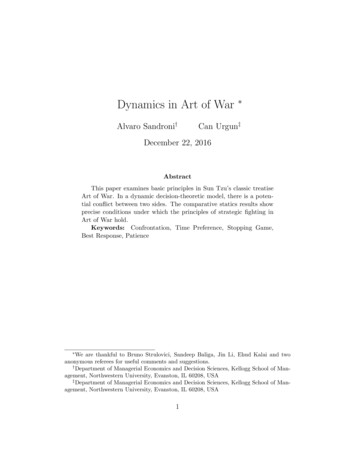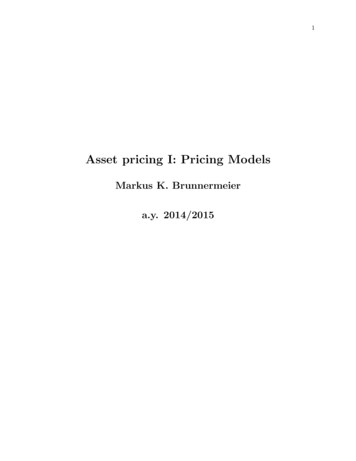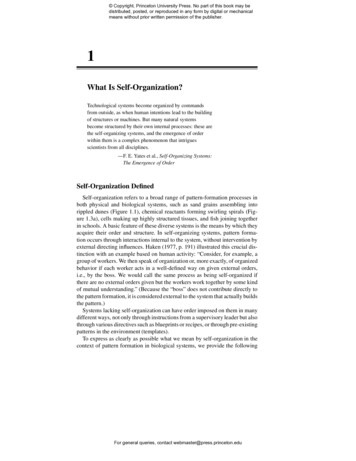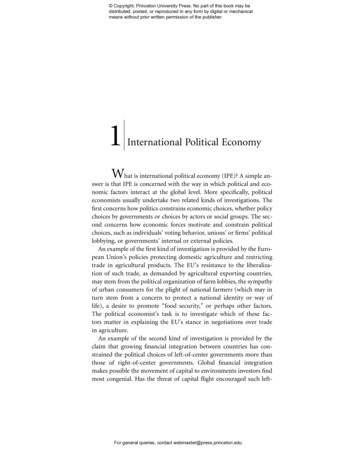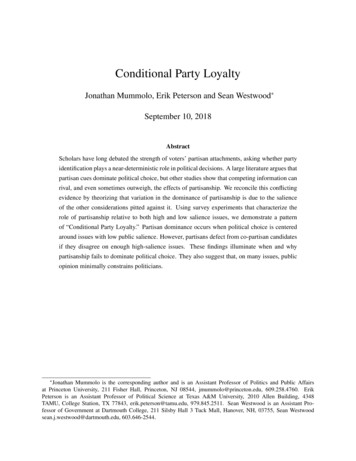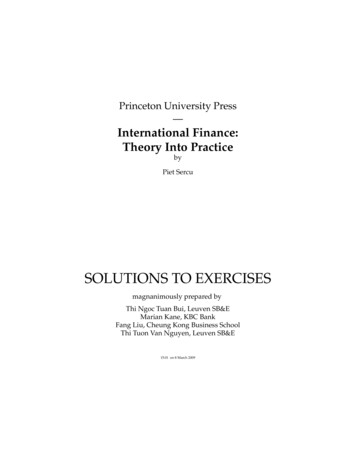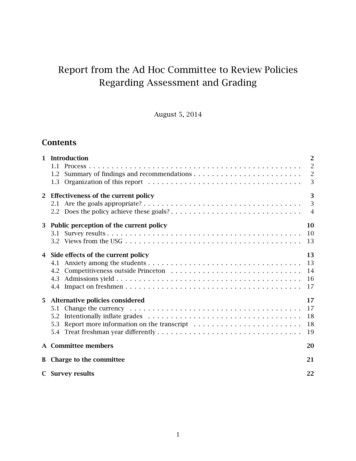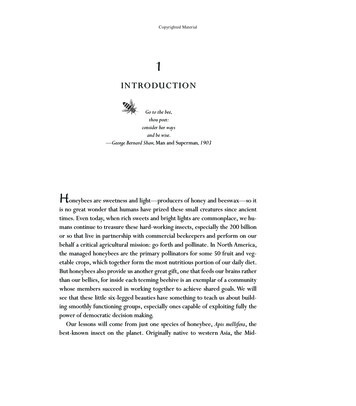
Transcription
Copyrighted Material1I nTroDUcTIonGo to the bee,thou poet:consider her waysand be wise.—George Bernard Shaw, man and Superman, 1903honeybees are sweetness and light—producers of honey and beeswax—so itis no great wonder that humans have prized these small creatures since ancienttimes. even today, when rich sweets and bright lights are commonplace, we humans continue to treasure these hard-working insects, especially the 200 billionor so that live in partnership with commercial beekeepers and perform on ourbehalf a critical agricultural mission: go forth and pollinate. In north america,the managed honeybees are the primary pollinators for some 50 fruit and vegetable crops, which together form the most nutritious portion of our daily diet.but honeybees also provide us another great gift, one that feeds our brains ratherthan our bellies, for inside each teeming beehive is an exemplar of a communitywhose members succeed in working together to achieve shared goals. We willsee that these little six-legged beauties have something to teach us about building smoothly functioning groups, especially ones capable of exploiting fully thepower of democratic decision making.our lessons will come from just one species of honeybee, Apis mellifera, thebest-known insect on the planet. originally native to western asia, the mid-
Copyrighted Materialfig. 1.1 a comb built of beeswax sculpted into hexagonal cells and filled with pollen fromvarious species of plants.dle east, africa, and europe, it is now found in temperate and tropical regionsthroughout the world thanks to the dispersal efforts of its human admirers. Itis a bee that is beautifully social. We can see this beauty in their nests of goldencombs, those exquisite arrays of hexagonal cells sculpted of thinnest beeswax(fig. 1.1). We can see it further in their harmonious societies, wherein tens ofthousands of worker bees, through enlightened self-interest, cooperate to serve acolony’s common good.and in this book, we will see the social beauty of honeybees vividly, and in fine detail, by examining how a colony achieves near-perfectaccuracy when it selects its home.choosing the right dwelling place is a life-or-death matter for a honeybee colony. If a colony chooses poorly, and so occupies a nest cavity that is too small tohold the honey stores it needs to survive winter, or that provides it with poorprotection from cold winds and hungry marauders, then it will die. given the vital importance of choosing a suitably roomy and snug homesite, it is not surpris4C h a P t er 1
Copyrighted Materialing that a colony’s choice of its living quarters is made not by a few bees actingalone but by several hundred bees acting collectively.This book is about how thissizable search committee almost always makes a good choice. We will uncoverthe means by which these house-hunting bees scour the neighborhood for potential nest sites, report the news of their discoveries, conduct a frank debate aboutthese options, and ultimately reach an agreement about which site will be theircolony’s new dwelling place. In short, we will examine the ingenious workingsof honeybee democracy.There is one common misunderstanding about the inner operations of a honeybee colony that I must dispel at the outset, namely that a colony is governedby a benevolent dictator, Her majesty the Queen. The belief that a colony’s coherence derives from an omniscient queen (or king) telling the workers what todo is centuries old, tracing back to aristotle and persisting until modern times.but it is false.What is true is that a colony’s queen lies at the heart of the wholeoperation, for a honeybee colony is an immense family consisting of the motherqueen and her thousands of progeny. It is also true that the many thousands ofattentive daughters (the workers) of the mother queen are, ultimately, all striving to promote her survival and reproduction. nevertheless, a colony’s queen isnot the royal Decider. rather, she is the royal ovipositer. each summer day, shemonotonously lays the 1,500 or so eggs needed to maintain her colony’s workforce. She is oblivious of her colony’s ever-changing labor needs—for example,more comb builders here, fewer pollen foragers there—to which the colony’sstaff of worker bees steadily adapts itself.The only known dominion exercised bythe queen is the suppression of rearing additional queens. She accomplishes thiswith a glandular secretion, called “queen substance,” that workers contacting herpick up on their antennae and distribute to all corners of the hive. In this way,these workers spread the word that their mother queen is alive and well, hencethere is no need to rear a new queen. So the mother queen is not the workers’boss. Indeed, there is no all-knowing central planner supervising the thousandsand thousands of worker bees in a colony.The work of a hive is instead governedcollectively by the workers themselves, each one an alert individual making toursof inspection looking for things to do and acting on her own to serve the community. Living close together, connected by the network of their shared enviI n troduCtI on5
Copyrighted Materialronment and a repertoire of signals for informing one another of urgent laborneeds—for example, dances that direct foragers to flowers brimming with sweetnectar—the workers achieve an enviable harmony of labor without supervision.Collective IntelligenceThis book focuses on what I believe is the most wondrous example of how themultitude of bees in a hive, much like the multitude of cells in a body, work together without an overseer to create a functional unit whose abilities far transcendthose of its constituents. Specifically, we will examine how a swarm of honeybeesachieves a form of collective intelligence in the choice of its home. as will bedescribed in chapter 2, the bees’ process of house hunting unfolds in late springand early summer, when colonies become overcrowded in their nesting cavities(bee hives and tree hollows) and then cast a swarm.When this happens, about athird of the worker bees stay at home and rear a new queen, thereby perpetuating the mother colony, while the other two-thirds of the workforce—a group ofsome ten thousand—rushes off with the old queen to create a daughter colony.The migrants travel only 30 meters (about 100 feet) or so before coalescing intoa beardlike cluster, where they literally hang out together for several hours or afew days (fig. 1.2). once bivouacked, the swarm will field several hundred househunters to explore some 70 square kilometers (30 square miles) of the surrounding landscape for potential homesites, locate a dozen or more possibilities, evaluate each one with respect to the multiple criteria that define a bee’s dream home,and democratically select a favorite for their new domicile. The bees’ collectivejudgment almost always favors the site that best fulfills their need for sufficientlyspacious and highly protective accommodations. Then, shortly after completingtheir selection process, the swarm bees implement their choice by taking flighten masse and flying straight to their new home, usually a snug cavity in a tree afew miles away.The enchanting story of house hunting by honeybees presents us with two intriguing mysteries. first, how can a bunch of tiny-brained bees, hanging from atree branch, make such a complex decision and make it well? The solution to thisfirst mystery will be revealed in chapters 3, 4, 5, and 6. Second, how can a swirl6C h a P t er 1
Copyrighted Materialfig. 1.2 a swarm of honeybees, with approximatelyten thousand worker bees and one queen bee.ing ensemble of ten thousand airborne bees steer themselves and stay togetherthroughout the cross-country flight to their chosen home, a journey whose destination is typically a small knothole in an inconspicuous tree in a remote forestcorner?The solution to this second mystery will be revealed in chapters 7 and 8.We will see that the 1.5 kilograms (3 pounds) of bees in a honeybee swarm,just like the 1.5 kilograms (3 pounds) of neurons in a human brain, achieve theircollective wisdom by organizing themselves in such a way that even though eachindividual has limited information and limited intelligence, the group as a wholemakes first-rate collective decisions. This comparison between swarms andbrains might seem superficial, but there is real substance here. over the last twodecades, while other sociobiologists and I have been analyzing the behavioralmechanisms of decision making by insect societies, neurobiologists have beeninvestigating the neuronal basis of decision making by primate brains. It turnsI n troduCtI on7
Copyrighted Materialout there are intriguing similarities in the pictures that have emerged from thesetwo independent lines of study. for example, the studies of individual neuronactivity associated with the eye-movement decisions in monkey brains and thestudies of individual bee activity associated with nest-site decisions in honeybeeswarms have both found that the decision-making process is essentially a competition between alternatives to accumulate support (e.g., neuron firings andbee visits), and the alternative that is chosen is the one whose accumulation ofsupport first surpasses a critical threshold. consistencies like these suggest thatthere are general principles of organization for building groups far smarter thanthe smartest individuals in them.We will explore these principles in chapter 9,where we will compare the decision-making mechanisms of bee swarms andprimate brains, and in chapter 10, where we will review the lessons that havebeen learned from the bees about how to structure a group so that it functionsas a smart decision maker.group decisions by humans are widespread and important, whether they aresmall-scale (e.g., agreements made among friends and colleagues), medium-scale(e.g., choices made in democratic town meetings), or large-scale decisions (e.g.,national elections or international agreements). not surprisingly, humans havepuzzled over how to optimize group decision making for millennia, at least sincePlato’s The Republic (360 bc) and no doubt long before, and yet many questions remain open about how humans can improve social choice. In chapter 10, Iwill offer some suggestions, what I call “Swarm Smarts” because they have beenlearned from the bees, on how human groups can organize themselves to improve their decision making. The american essayist Henry David Thoreau expressed skepticism about the wisdom of crowds when he wrote, “The mass nevercomes up to the standard of its best member, but on the contrary degrades itselfto a level with the lowest.” The german philosopher friedrich nietzsche waseven more negative about group intelligence when he wrote, “madness is rare inindividuals—but in groups . . . it is the rule.” certainly there are many examplesof groups making lousy decisions—think of stock market bubbles or of deadlystampedes from burning buildings—but the reality of honeybee swarms makinggood decisions shows us that there really are ways to endow a group with a highcollective IQ.8C h a P t er 1
Copyrighted MaterialDancing BeesThe scientific story told in this book started in germany almost seventy yearsago, in the summer of 1944, when a distinguished professor of zoology at theUniversity of munich, Karl von frisch, made a revolutionary discovery for whichhe would eventually receive the nobel Prize: an insect, the worker honeybee,can inform her hive mates of the direction and distance to a rich food source bymeans of dance behavior. von frisch had already known for nearly thirty yearsthat when a lone forager finds a rich source of nectar, she returns excitedly to herhive and performs a conspicuous “waggle dance.” In performing this eye-catchingbehavior, the dancer walks straight ahead on the vertical surface of a comb, waggling her body from side to side, then she stops the “waggle run” and turns left orright to make a semicircular “return run” back to her starting point, whereuponshe produces another waggle run followed by another return run, and so on (fig.1.3). each waggle dance consists, therefore, of a series of dance circuits, and eachdance circuit contains a waggle run and a return run.von frisch also knew that abee may continue dancing for some seconds or even some minutes, all the whiletrailed by unemployed foragers that, in his own words, “take part in each of hermanoeuvrings so that the dancer herself, in her madly wheeling movements, appears to carry behind her a perpetual comet’s tail of bees.” furthermore, he knewwell that after a dance-follower has tripped along behind a dancer throughoutseveral circuits of her dance, she rushes out of the hive to search for the bonanzaannounced by the dancing bee. but before 1944, von frisch thought that the onlything the dance-followers learned from the dancer was the fragrance of the flowers she had visited—which they detected by holding their antennae close to thedancer to smell the floral scents adhering to her body—and that upon leaving thehive the newly aroused bees simply searched in ever-expanding circles until theydiscovered flowers with the memorized fragrance.What von frisch discovered in1944 was nearly incredible: the dance-followers did not search for flowers withthe matching scent everywhere around the hive, but only in the vicinity of wherethe dancer had foraged, even if she had foraged in a remote spot, such as alonga shady lakeside trail far from the hive. Without a doubt, the newcomers weresomehow acquiring from the successful forager information about food-sourceI n troduCtI on9
Copyrighted Materialfig. 1.3 The movement pattern of a workerbee performing a waggle dance on the vertical surface of a comb inside her colony’s hive.The bee is shown performing two circuits ofthe waggle dance.location as well as food-source scent. could this location information be communicated inside the hive, by means of the bees’ dances?Th
—George Bernard Shaw, man and Superman,1903 h oneybees are sweetness and light—producers of honey and beeswax—so it is no great wonder that humans have prized these small creatures since ancient times. even today, when rich sweets and bright lights are commonplace, we hu-mans continue to treasure these hard-working insects, especially the 200 billion or so that live in
